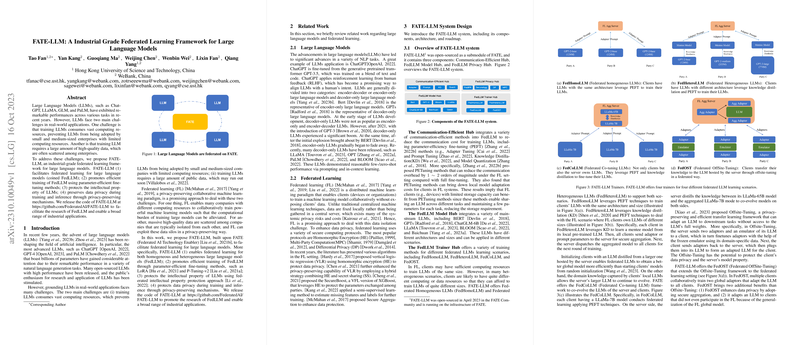FATE-LLM: An Industrial Grade Federated Learning Framework for LLMs
The emergence of LLMs has significantly influenced advancements in NLP tasks in recent years. As these models, such as GPT-4 and PaLM, have scaled in size and capability, they have brought to light two significant challenges in their deployment: the requirement for substantial computational resources and the necessity for large volumes of high-quality training data, which are often inaccessible to smaller enterprises. The paper "FATE-LLM: A Industrial Grade Federated Learning Framework for LLMs" addresses these challenges by proposing a federated learning framework specifically designed for LLMs, titled FATE-LLM.
Objectives and Methodology
FATE-LLM's objective is to facilitate LLM training and deployment using federated learning (FL), thereby enabling organizations with different resource capacities to collaboratively train models without sharing their data. The framework focuses on four key aspects:
- Enabling Federated Learning for LLMs (FedLLM): Facilitating collaborative and distributed model training among multiple parties, catering to both homogeneous and heterogeneous LLM architectures.
- Parameter-Efficient Fine-Tuning: Implementing techniques like LoRA and P-Tuning-v2 to efficiently fine-tune models by training only a subset of parameters, which reduces both computational and communication costs in a federated setup.
- Intellectual Property Protection: Employing mechanisms to ensure that the intellectual property of LLMs remains protected throughout the training process.
- Privacy Preservation: Incorporating privacy-preserving mechanisms to safeguard sensitive data during both training and inference stages.
FATE-LLM leverages existing protocols from federated learning to protect privacy and intellectual property. It adopts techniques such as Secure Aggregation, Homomorphic Encryption, and Differential Privacy.
Framework Components
FATE-LLM is implemented as a component of the FATE (Federated AI Technology Enabler) infrastructure. Key components of the FATE-LLM system include:
- Communication-Efficient Hub: Integrates PEFT methods, knowledge distillation, and model quantization to minimize communication overhead.
- FedLLM Model Hub: Provides a repository of various LLM architectures, such as BERT, GPT, and LLaMA, adaptable for diverse application scenarios.
- FedLLM Trainer Hub: Offers training methodologies for different federated LLM architectures, specifically FedHomoLLM, FedHeteroLLM, FedCoLLM, and FedOST.
Experimental Evaluation
The authors conduct experiments using a federated setup with ChatGLM-6B, employing various PETuning strategies like LoRA and P-Tuning-v2. The results suggest that federated versions of these fine-tuning methods demonstrate enhanced performance over individual client fine-tuning approaches. However, federated fine-tuning still lags behind centralized methods in terms of absolute performance metrics. This highlights potential areas for improving federated fine-tuning processes.
Moreover, the significant reduction in communication costs, highlighted by the parameter size reduction in PETuning methods to as low as 0.058% of the total parameters, underscores the efficacy of the approach in resource-limited scenarios.
Implications and Future Directions
The FATE-LLM framework represents a robust avenue for extending the reach of LLM capabilities to a wider range of organizations, particularly those with constrained resources. This framework reduces barriers to entry for small and medium-sized enterprises, promoting broader adoption of advanced AI technologies.
Future research directions as suggested by the paper include enhancing federated learning to handle LLMs of varied architectures, enabling private LLM training with cross-party data while maintaining privacy, improving user prompt privacy during inference, and exploring applications in vertical federated learning contexts.
Overall, FATE-LLM aligns with the evolving needs of industry and research, providing a platform that balances the complexities of LLM scale with pragmatic considerations of data privacy and computational efficiency. Despite being in its iterative updates, its contributions to federated learning frameworks represent significant advancement in democratizing access to LLM resources.
